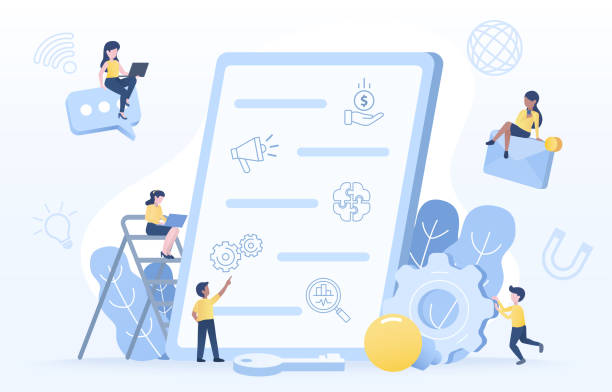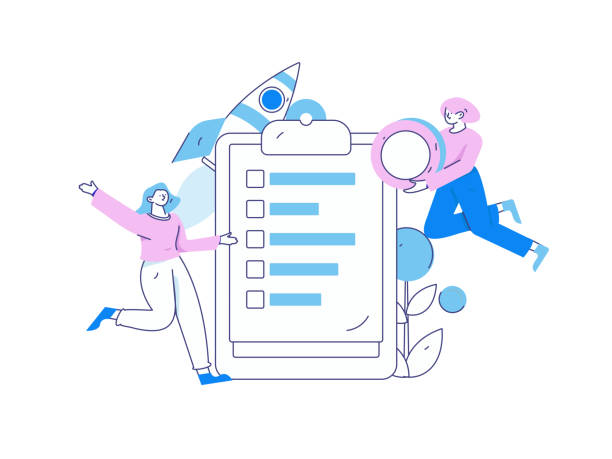The Importance of Entering Global Markets

In today’s world, where geographical boundaries are fading and the internet has become a powerful tool for global communication, a strong and multilingual online presence is vital for any business seeking growth and development.
#Multilingual_website_design is no longer a competitive advantage; it’s a necessity to connect with your potential customers worldwide.
This approach allows you to deliver your message in the audience’s native language, which leads to increased trust and improved user experience.
Imagine a user from Japan or Germany visiting your website and finding the information they need in their own language; this experience not only keeps them satisfied but also significantly increases the likelihood of them becoming a loyal customer.
Multilingual website design allows you to introduce your products and services to a much broader audience without language limitations. This strategy is particularly beneficial for e-commerce companies, online service providers, and content platforms aiming to attract international traffic.
This goes beyond simple text translation; it involves cultural understanding and providing content that aligns with local norms.
Therefore, for any business with a vision of #business_expansion in the #global_market, investing in multilingual website design is a strategic and smart step.
Did you know that 94% of a company’s first impression relates to its website design?
Rasaweb helps you create the best first impression by offering professional corporate website design services.
✅ Creating a professional and trustworthy image for your brand
✅ Easier attraction of potential customers and improvement of online standing
⚡ Get free corporate website design consultation
Advantages and Challenges of Implementation

Implementing a multilingual website offers significant advantages that can dramatically increase your market share and improve customer conversion rates.
These benefits include access to new markets, increased brand credibility internationally, and improved global SEO.
Multilingual websites help search engines correctly index your content and display it to the right users worldwide.
This is crucial, especially for businesses looking to benefit from global e-commerce.
However, while there are many advantages, there are also challenges in multilingual website design that need to be carefully considered.
These challenges include technical complexities such as URL structure management, proper implementation of Hreflang tags for language and region identification, and ensuring the compatibility of the Content Management System (CMS) with various languages.
Furthermore, the accuracy of content translation and localization, including images, dates, and currency units, is a fundamental challenge.
Overlooking cultural differences can lead to misunderstandings and even damage to the brand.
Continuous maintenance and updating of content in all languages also require resources and meticulous planning.
All these aspects must be considered in the multilingual website design process to ensure project success and prevent resource waste.
Technical and Infrastructure Considerations

Multilingual website design, from a technical perspective, requires attention to detail and strategic decisions.
One of the most important aspects is choosing the appropriate URL structure for different language versions.
Three main approaches include using subdomains (e.g., en.example.com), subdirectories (e.g., example.com/en), or country-specific top-level domains (gTLD) (e.g., example.de).
Each has its own advantages and disadvantages in terms of SEO, hosting, and management.
Also, the correct use of Hreflang tags in HTML code or HTTP headers is vital for informing search engines about different language versions of a page, preventing duplicate content issues, and directing users to the correct language version.
Choosing a powerful and flexible Content Management System (CMS) that fully supports multilingual capabilities, such as WordPress with plugins like WPML or Polylang, or Drupal and Joomla, is crucial.
The server infrastructure must also be capable of hosting and serving content in various languages without performance degradation.
Security and loading speed across all language versions should also be prioritized.
Ignoring these technical points can lead to a poor user experience and low search results ranking.
Therefore, meticulous technical planning for multilingual website design is the foundation of your project’s long-term success.
| Addressing Method | Example | Advantages | Disadvantages |
|---|---|---|---|
| Subdirectory | example.com/en/ |
Easy management, sharing main domain authority, stronger SEO | May make it slightly difficult for users to understand specific country targeting |
| Subdomain | en.example.com |
Clear language separation, hosting on different servers, good scalability | May require a bit more effort for SEO, more SSL certificate management |
| Country-code Top-Level Domains (ccTLD) | example.de |
Clearest geographical indicator, high local credibility, suitable for targeted markets | High cost, need to purchase and manage multiple domains, more technical complexity |
Content Translation and Localization

Simply translating content is not enough for successful multilingual website design; localization is a step beyond that.
Localization means adapting content to the culture, norms, and expectations of local audiences.
This process includes precise text translation, adapting terms and phrases to cultural equivalents, and also adjustments related to dates, currency units, phone numbers, and even colors and images.
For example, an image that has a positive meaning in one culture might be misinterpreted in another.
Using professional, native translators who are familiar with cultural and linguistic nuances is far more crucial than relying on machine translations, which often lack the necessary accuracy and cultural sensibility.
A poor translation can not only undermine your brand’s credibility but also fail to convey your message correctly.
Proper localization gives users a sense of closeness and belonging, as if the website was designed for them from the outset.
This is especially important for marketing and sales content that needs to create an emotional connection with the audience.
The localization process should include repeated reviews by native speakers to ensure the accuracy and appropriateness of the content.
Ultimately, the quality of localized content plays a key role in the ultimate success of your multilingual website design project.
Are you dissatisfied with the low conversion rate of visitors to customers on your e-commerce site?
Solve this problem forever with professional e-commerce website design by Rasaweb!
✅ Increase visitor-to-customer conversion rate
✅ Create an excellent user experience and build customer trust
⚡ Get a free consultation
Search Engine Optimization for Multilingual Websites

For your multilingual website design to be truly effective and attract international traffic, Search Engine Optimization (SEO) is essential for each language version.
This process goes beyond keyword translation; it involves independent keyword research for each language, as search terms vary across different cultures and languages.
It must be ensured that the chosen keywords correctly match the searcher’s intent in that language.
Additionally, the correct use of Hreflang tags, previously mentioned, is crucial to prevent duplicate content issues and to properly guide users to the appropriate language and regional version of the website.
Proper configuration of Google Search Console for international targeting and specifying target languages for each domain or subdirectory is another key step.
Building high-quality backlinks from local and reputable websites in each target country also significantly helps strengthen your SEO ranking.
Furthermore, optimizing page loading speed and ensuring the website’s responsiveness across all devices and for all languages are important SEO factors.
A comprehensive and language-focused SEO strategy ensures the success of your multilingual website design in attracting organic traffic and transforms it into a powerful tool for reaching global audiences.
User Experience and User Interface Design

User Interface (UI) design and User Experience (UX) play a vital role in the success of a multilingual website.
The design should allow users to easily select their desired language and have a consistent and enjoyable user experience in every language.
Placing the language switcher in an accessible and prominent location (usually in the header or footer) is essential.
Furthermore, cultural differences in design must be considered.
For example, languages like Persian and Arabic are written from right-to-left (RTL), while many European languages are left-to-right (LTR).
This difference requires changes in page layout, text direction, and even the placement of icons and menus.
Colors and images should also be chosen with consideration for the cultural sensitivities of each region to prevent any misinterpretation or negative consequences.
The visual design should align with the aesthetic expectations of local audiences.
Font sizes and typefaces should also be optimized for optimal readability in each language.
The main goal in multilingual website design is to create a smooth and natural user experience that guides the user towards their objective and creates a sense of familiarity and comfort, as if the website was specifically designed for them.
This aspect of design is as influential as content and SEO in the overall success of a multilingual website.
Suitable Tools and Platforms

Choosing the right tools and platforms for multilingual website design can make a big difference in project success and ease of management.
Popular Content Management Systems (CMS) like WordPress, Drupal, and Joomla, each offer multilingual capabilities either natively or through plugins and modules.
WordPress, with plugins like WPML and Polylang, provides the ability to manage content in various languages and is highly suitable for small to medium-sized businesses.
Drupal and Joomla, due to their high flexibility and power, are also good options for larger and more complex projects.
In addition to CMS, using Translation Management Systems (TMS) can simplify and streamline the translation and localization process.
These systems help manage translation teams, monitor progress, and ensure quality.
Tools like Smartling or Transifex are among the leading TMS.
Some e-commerce platforms like Shopify and Magento also have their own multilingual plugins and solutions.
Ultimately, selecting the right tool depends on the specific project needs, budget, and available technical resources.
Thoroughly examining the features and compatibility of tools with each other is crucial to ensure a strong and manageable infrastructure for your multilingual website.
These tools help ensure that the process of multilingual website design, development, and maintenance is smooth and optimized, providing an optimal user experience across all languages.
| Tool Type | Tool/Platform Name | Primary Use | Advantages |
|---|---|---|---|
| CMS with Multilingual Plugin | WordPress (WPML, Polylang) | Multilingual content management, easy translation of pages and posts | Large user community, diverse plugins, easy user interface |
| Native Multilingual CMS | Drupal, Joomla | Powerful built-in multilingual capabilities, suitable for large projects | High flexibility, high security, scalability |
| Translation Management System (TMS) | Smartling, Transifex, Phrase | Manage translation process, team collaboration, translation memory (TM) | Increase translation speed and quality, reduce long-term costs |
| E-commerce Platforms | Shopify (Langify), Magento | Create multilingual online stores | International payments, inventory management, marketing tools |
Continuous Maintenance and Updates

After the completion of multilingual website design, the work does not end; rather, the phase of continuous maintenance and updates begins, which is vital for preserving the website’s relevancy and efficiency over time.
Content in all languages must be regularly updated to reflect your latest information, products, and services.
This includes news updates, blog articles, and product specifications.
Neglecting to update a language version can lead to information inconsistency and user confusion.
In addition to content, the technical aspects of the website also require continuous maintenance. This includes updating the Content Management System (CMS), plugins, and themes to ensure optimal security and performance.
Monitoring website performance, including page loading speed across all languages and in different geographical regions, as well as checking for broken links and 404 errors, are other important measures.
Regular SEO audits are essential to ensure that Hreflang tags are working correctly and the website ranks well in local search engines.
Also, collecting feedback from users in different languages and using it to improve the user experience is a crucial part of this process.
Investing in continuous maintenance ensures the longevity and effectiveness of your multilingual website design and helps you remain competitive in international markets.
Are you worried your old company website might scare away new customers? Rasaweb solves this problem with modern and efficient corporate website design.
✅ Increases your brand’s credibility.
✅ Helps attract targeted customers.
⚡ Contact Rasaweb for a free consultation!
Common Mistakes and Ways to Avoid Them

In the process of multilingual website design, common mistakes exist that can render your efforts fruitless.
One of the biggest mistakes is relying solely on machine translation without review by native translators.
This often leads to inaccurate, nonsensical, and even offensive translations that harm your brand’s credibility.
The solution is to invest in professional translators and complete content localization.
Another mistake is neglecting international SEO. Simply translating keywords is not enough; keyword research must be conducted separately for each language, and Hreflang tags must be implemented correctly.
Also, sometimes website owners forget that different technical requirements exist for various languages, such as URL structure and server infrastructure.
Failure to consider cultural differences in visual and content design can also lead to audience repulsion.
For example, using images or colors that are popular in one culture but have negative connotations in another.
Poor content management and infrequent updates of different language versions result in users receiving outdated information.
To prevent this problem, a comprehensive content plan for all languages is essential.
Additionally, insufficient testing of the website in different languages and across various browsers can lead to performance issues and a poor user experience.
By recognizing these common mistakes and adopting preventive solutions, you can successfully complete your multilingual website design project and benefit from all its advantages.
Future and Upcoming Trends

The future of multilingual website design is rapidly evolving, with new trends emerging that will impact how businesses interact with global audiences.
One of the most significant of these trends is remarkable advancements in Artificial Intelligence (AI) and Neural Machine Translation (NMT).
While human translation remains highly important, AI-powered tools are increasingly capable of producing more accurate and natural translations, which can accelerate the localization process and reduce costs, especially for large volumes of content.
It is expected that in the future, websites will leverage AI capabilities to provide a more personalized user experience based on language, region, and even individual user preferences.
The emergence of voice search and voice assistants in different languages will also require new approaches to multilingual SEO.
Businesses must optimize their content to respond to voice queries in various languages.
Augmented Reality (AR) and Virtual Reality (VR) also hold potential for creating more immersive multilingual experiences.
Ultimately, a focus on flawless user experience, deeper localization, and leveraging emerging technologies will determine success in the competitive world of multilingual website design.
Those who anticipate these trends and implement them in their strategies will lead in attracting and retaining global audiences.
Frequently Asked Questions
| Question | Answer |
|---|---|
| What is multilingual website design? | The process of creating a website whose content is available to users in more than one language. |
| Why should we make our website multilingual? | To access a larger global audience, improve user experience for non-native speakers, and increase sales or engagement. |
| What are the methods for implementing a multilingual website? | Using subdomains, subdirectories, or URL parameters, or using different Top-Level Domains (TLDs) for each language. |
| Which method is better for SEO? | Generally, using subdirectories (e.g., example.com/fa/) is recommended for SEO because they share the main domain’s authority. |
| What is the hreflang tag and what is its use? | The hreflang tag is an HTML attribute that helps search engines understand which version of a page is appropriate for a specific language or region. |
| Is machine translation sufficient for multilingual website content? | Usually no. For providing a good user experience and maintaining credibility, professional translation and content localization are essential. |
| What does Localization mean? | The process of adapting the content, design, and functionality of a site to the culture, language, currency, and other specific characteristics of a target region or country. |
| What is the importance of language selection in multilingual website design? | Users should be allowed to easily choose their desired language, usually through a clear button or menu in the site’s header. |
| What are the challenges in multilingual website design? | Managing content in different languages, maintaining consistency in design and user experience, multilingual SEO, and translation and maintenance costs. |
| What features should a suitable Content Management System (CMS) have for a multilingual website? | It should allow easy content management in various languages, support multilingual URL structures, and have plugins related to translation and localization. |
And other advertising services of Rasaweb Advertising Agency
Smart UI/UX: Revolutionize SEO ranking with marketing automation.
Smart Custom Software: An effective tool for customer acquisition with SEO-driven content strategy.
Smart Direct Marketing: A blend of creativity and technology for online growth through attractive UI design.
Smart Advertising Campaign: Transform user engagement with precise audience targeting.
Smart Customer Journey Map: Revolutionize digital branding with Google Ads management.
And over hundreds of other services in internet advertising, advertising consultation, and organizational solutions
Internet Advertising | Advertising Strategy | Advertorial
Sources
Importance of Multilingual Website Design
Advantages of Multilingual Website Design
Guide to Building a Multilingual Website
Impact of Multilingual Website on Global Marketing
? For your business to shine in the digital world, Rasaweb Afarin Digital Marketing Agency, specializing in professional website design, SEO, and comprehensive digital marketing strategies, paves your path to success.
📍 Tehran, Mirdamad Street, next to Bank Markazi, Kazeroon Jonubi Alley, Ramin Alley, No. 6


